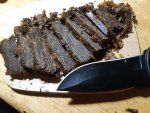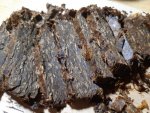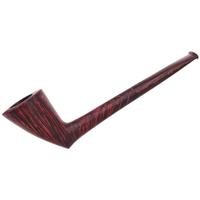Burley takes at least a year aging if you don't kiln. Two is better.
Here's some good stuff
"Ammonia is created within the leaf during oxidation of the leaf's proteins. If there is no oxidation, then there is no ammonia produced. The oxidation is not caused by microbes or air, but by two oxidase enzymesstill present within the leaf after the lamina have died. Both require moisture to function in breaking down albuminous proteins and carbohydrates. One of the enzymes is destroyed if the leaf reaches 141°F, so is lacking in flue-cured leaf
after it has been flue-cured. The more heat-stable enzyme survives and functions up to about 191°F. This second oxidase enzyme operates much more slowly than the first, but it is what permits flue-cured leaf to
very slowly age. Once leaf has been heated above 191°F, it can no longer age. So toasted leaf and Cavendish or otherwise boiled or steamed leaf no longer has the ability to age in the sense that we understand tobacco aging.
"Sweating" is an imprecise term with many meanings. "Fermentation", likewise offers its own confusions. Both of them refer to conditions that allow the process of oxidation discussed in the previous paragraph. The leaf must have some moisture (is not completely dry), and must be at a temperature of about 60°F or higher. Since the oxidation reaction is temperature dependent, the higher the temp, the more rapidly the reaction runs (up to the point that the enzyme itself is cooked or denatured).
Cured leaf that is hanging in a humid shed or tobacco barn while temperatures rise (as in the springtime) will resume enzymatic oxidation. The rate of that oxidation tends to cycle with the ambient temperature. Once most of the proteins and carbs have been oxidized (incidentally releasing ammonia radicals from certain proteins), the rate slows dramatically, though it can continue for years at a snail's pace.
Cured leaf that is closely packed within bales or into piles (pilones) acts as its own insulation, so that the slight, chemical heat generated by the oxidation is trapped, increasing the oxidation rate and thereby generating even more heat. So baled or piled tobacco can warm itself (even to the point of starting a smoldering fire, if the conditions are just right). When this happens in bales, simply separating the individual bales with a slight air space will often be enough to slow or halt the process. When this occurs during intentional "fermentation" piles, the temperature is allowed to reach a previously decided max temp, at which the pile is broken down and reassembled, and the process started over again.
"Aging" of tobacco refers to
exactly the same chemical process of oxidation. Once most of the work of oxidation has been completed, "aging" appears as a subtle, gradual process. But it's the very same thing happening (at a slower rate) as happens with "sweating" and "fermentation".
We often say things like "burley is not fermented," and "cigar leaf is always fermented." The only real difference is that most cigar varieties require a lot more oxidation to tame the proteins and carbohydrates, when compared to burley or other non-cigar varieties. "Fermenting" non-cigar varieties does not cause them to smell or taste like cigar varieties. Those distinct characteristics are inherent within the specific tobacco varieties.
Kilning
A kiln allows you to achieve the moisture and temperature conditions required for optimal oxidation rates. It's not dependent on bailing or creating 5000 pound piles, or waiting for the weather to be just right. The kiln enforces the humidity, and enforces the desired temperature. It's the same as "sweating" or "fermentation" or "aging". Once the leaf has mostly oxidized its proteins and carbohydrates, all that remains to be accomplished is a "resting" and "airing" period (days to weeks) in order to allow the newly created ammonia that is still dissolved within the moisture of the leaf lamina to dissipate into the air. Allowing the leaf to completely dry (go out of case) can speed this process of ammonia evaporation. The leaf, of course, needs to be brought back into low case prior to handling.
If kilned or "sweated" or "fermented" or "aged" tobacco has an ammonia smell, it means that additional oxidation has taken place."
thanks Lemon refers to the color. It is a lighter shade of yellow than the average flue-cured tobacco. VA refers to the American state of Virginia.

fairtradetobacco.com

















